September 19th, 2010 · 1 Comment
I think that one of my favorite things about London is its parks. I have mentioned before in some of my other posts that I don’t think I could ever live in a big city – the crowds and the hurry and the size just stress me out too much. I’ve found that parks are one of the few places where you can have space to walk down a path in a straight line without having to dodge and weave and bump into people and say “sorry.” I’ve found that parks are also a place where you are pretty much guaranteed a place to sit, and you don’t necessarily have to be within ten feet of another person either. It’s lovely that London thought to create places where there is enough space for large amounts of people to be, unlike on the tube or on the streets, where there just simply isn’t. The peace is more beautiful to me than all the trees and flowers and landscaping, although that is pretty too, and a nice break from the architectural chaos of London. I think you really could lose yourself and forget about the city for awhile in parks if you wanted to. When I visited Hyde Park*, I took the following two pictures of the lake:
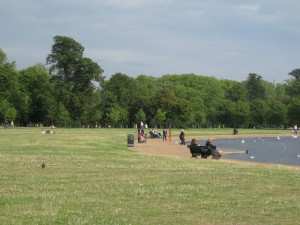
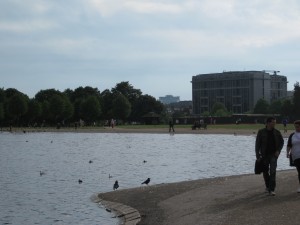
Oh right, the city. There it is. These two pictures seem a bit incongruous; you could probably lie, and tell people that they are different lakes in different places, and they might believe you.
It seems that parks have several different uses for people in London. The first park I visited was St. James Park, and there I joined many other people picnicking on their lunch break. This seems much more enjoyable than inhaling a sandwich on the tube, and if I ever were to work in London, I would want a job where I could eat lunch in the park. The other side of the bridge at St. James however, toward Buckingham Palace, is much more touristy. I was alerted to this by the presence of an ice cream stand, and chairs that you could pay to sit in. I don’t see this as a problem though, as tourists, I am sure, also need a break from the city. Other uses I have seen for parks include
dog walking
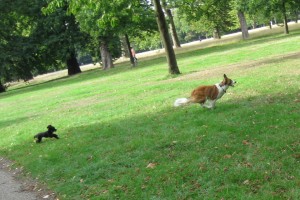
dates

studying

or just being alone and doing whatever you want.

A last really important use for parks, I think, is creating a safe space for children. Professor Qualls brought up this point on the Bloomsbury walking tour, when he took us past the Coram playground, and explained that it was fenced off because you were not allowed in unless you had a child. I saw this again at the Princess Diana Memorial Playground in Hyde Park. It was fenced, plus there was a guard at the door checking people. I witnessed a man come up to the guard and ask if he could see if his wife was in there with his son. The guard told him he could not go in. While this man probably was the father of a child, it is also possible that he could have been a child snatcher, and I personally am a fan of this playground rule that protects children against them. I don’t think we have this in America, or at least I’ve never seen it. At the playground near my house, high school kids smoke pot after school.
While I am excited to move to Norwich and escape the city more or less permanently, when I do return to London, parks will be on my list of places to revisit.
*Note: I am not exactly sure where Kensington Gardens ends and Hyde Park begins. This lake could very well technically be in Kensington Gardens. My apologies to Kensington Gardens if this is the case.
**Note also: all photos in this post are mine. Sorry if you think I’m creepy for taking pictures of random people. It was all in the spirit of academia.
Tags: 2010 Kaitlin
September 19th, 2010 · No Comments
The parks in London, as people have already noted, are places of beauty and enjoyment. Yet, they are not all created equal, well, no, used equally. When relaxing in various ones, I noticed that some were more touristy. In fact, within some, one area was more likely to be touristy that an other.
My first introduction to a London park was when we had class in Russell Square. Clearly, people weren’t used to seeing a group of students (much less Americans) in August discussing various ideas about immigration. Yet, I can’t imagine being at UCL and not using the space for at least small study groups, if not classroom discussions when the weather turns nice.
I adore the idea of small squares littered throughout the city ready for use whenever someone wants an escape from the business and chaos of the city. Of those I noticed, the squares I most wanted to go into were locked and only accessible by the area’s residents. I have mixed feelings on this. On one hand, it’s great for residents to have a safe place to go with their young children or a quiet place where they don’t have to worry about tourists wandering through talking loudly (oops). On the other, why shouldn’t these spaces be opened up for everyone? It feels like one more thing that add to English hypocrisy: they want to pretend when it’s convenient that class doesn’t count, but it seems to exist in these situations when the restricted squares seem to be in areas where income looks to be higher.
For the actual parks, my favorite has been Kensington Gardens. I loved the duality of the park: one side was quiet and peaceful and the other was busy, well, as busy as a park can be. Residents played with their dogs as tourists wandered through taking photos and trying to find the actual park, Hyde Park. Hyde Park was also rather enjoyable, but was far busier on the day I visited. Granted, searching for the Peter Pan statue also lends the visit to being centered around the busier areas. I enjoyed walking through Kensington and observing people and how they interacted with the space (mostly walking their dogs or playing fetch with them, as well as a few taking their young children out for a walk). In Hyde I felt like I was only there to check it off of my list of “Things To Do in London.”
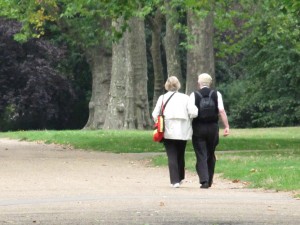
Regent’s Park, while a lot like Hyde in some regard also demonstrated this dualistic atmosphere. The park seemed to have a few tourists wandering through (especially as you got closer to the Zoo and in the more French style areas), but it also had a lot of Londoners, some out walking and others with their family (or dogs). I much preferred the areas that were mostly charming (and alarmingly uneven) paths, where others were walking with their dogs. The other thing that I liked about Regent’s was how family friendly it was. There was a playground that was obviously popular among families with young children.
I’ve enjoyed the parks that I’ve visited and they’ve helped convince me that London is actually my favorite city in the world because of their place in the life of the average Londoner (or student visiting for the month): they’re key to staying sane here. I thrive on the chaos of the city, but sometimes nothing is better than a quiet stroll through a park or an hour reading in a square. I hope that as I venture to other places in England that I will be able to go to a few other cities’ gardens/squares/parks and see how they differ.
Tags: 2010 Stephenie
September 19th, 2010 · No Comments
As you all probably know, the Jewish high holidays, Rosh Hashana and Yom Kippur were over this past week and a half. The combination of these days and being in a new place has, along with making me more than a little homesick, made me curious to explore Jewish communities in London. I was lucky enough to encounter three very Jewish communities here: the West London Synagogue, which I attended for Rosh Hashanah services, the Liberal Jewish Synagogue, for Yom Kippur services, and The Central London Synagogue, which we visited as a group.
As with the various Jewish communities in the States, these three synagogues were drastically different from one another. The Central London Synagogue (where I did not attend a service), is Orthodox. I could tell the moment that we walked in, based on the layout of the sanctuary, with separate seating for men and women. The West London Synagogue is Reform, but I did not experience the type of Reform Jewish service that I am accustomed to at home: it was over all more “traditional reform,” with less music, and even less Hebrew than I prefer. The Liberal Jewish Synagogue’s service was easily my favorite, probably because it was the most like the synagogue that I grew up attending. There, the audience sang along with the choir and the rabbi. Some folk music was incorporated, and I heard and read along with more Hebrew than at the Reform service, although many prayers were still said in English. I finished a very personally fulfilling Yom Kippur by taking a walk in Regents Park and talking with my family on the phone.
But what struck me more than the disorientation I experienced as I explored the various synagogues, was how much felt familiar. Fundamentally, I experienced the same prayers, similar music, a few people conspicuously wearing mesh sneakers with their dresses or suits, so as not to wear leather on Yom Kippur, and many congregants greeting each other enthusiastically with “Shana Tovah,” (have a good new year). (Even many aspects of the Orthodox synagogue were very familiar, though I do not agree with much of the Orthodox viewpoint.) It made me think of what I was often told by adults when I was younger, but never gave much thought to: wherever in the world I go, I can find something familiar by visiting a Jewish community.
Despite (and maybe because of) the familiarity, I was startled near the end of the first service I attended to hear a prayer for the queen. I wondered if it was historically based, maybe something required in all religious services in England during a certain time period. But this added prayer turned out a difference that demonstrated another similarity.
Our guide at the Orthodox synagogue that we visited explained a stained glass window that honored the Queen by telling us that a prayer for the Queen is added because the safety of the Jews always depends on the safety of the country in which they are living. Therefore, the prayer for the Queen corresponds to the prayer briefly said at my synagogue at home for peace within “our nation.” So saying a prayer for “our Sovereign Lady Queen Elizabeth,” is just a very English way of following a custom that I have seen in services for my whole life. I wonder how many other differences in Jewish customs and synagogues worldwide can be traced back to the same ideas as one another.
Tags: 2010 Emily · Uncategorized
September 19th, 2010 · 1 Comment
Frankly, I just don’t get it. I flat out do not understand how the Brits have (supposedly) built their entire social culture around pubs. You feel awkward going in, all you want to do is apologise and the food and drink are usually overpriced. That has been my experience, at least.
To be fair, I don’t plan on (once I turn 21) frequenting bars in the States. Like pubs, these are usually loud, overcrowded places mostly filled with people who have had a few too many. I’m the sort of person who would rather share a bottle of wine over dinner than specifically go out to a place to get drunk, as I think many people do.
My most positive pub experience came about after I had spent the afternoon alone going to museums. I was heading back towards the Tube from the Tate Britain when I realised that I was extremely hungry. I looked around to find some food (absolutely dreading the idea of ANOTHER sandwich from Planet Organics) and the first decent-looking place I found happened to be a pub. It was in a good area, close to the Tube, well-lit and not crowded, so I went for it. It was the White Swan Pub (photo: http://www.localdatasearch.com/london/victoria/public_houses_inns/the_white_swan-10005712)

As I walked in the door, panic began building in my mind. I mentally flipped through the pages of Watching the English, trying to remember pub protocol. Seat yourself . . . order at the bar . . . But how do I claim a table without leaving my stuff there to be stolen? Do I move the place settings or something to subtly signal that I have chosen the seat as my own? Should I only order a drink first or food at the same time?
Finally, I just approached the bar and asked rather nervously “Erm . . . do I order food up here as well?” The server gave me a lookover and then responded “Yeah.” Without even looking at the menu, I asked for fish and chips, declined to order anything to drink and paid. After sitting back down at my table, I felt awkward and decided to go back to the bar. I needn’t have bothered for a new person helped me as I tripped over myself saying “Oh. Uh, I changed my mind. . . c-could I get a half-pint of Guinness? Do you do half-pints?” Amused, he gave me my half-pint and I headed back to my table with my metaphorical tail between my legs.
The staff must have figured out that I was feeling a bit lost – plus business was slow – so they sent my waiter over at least twice to check on me as I nursed my Guinness with all the diligence of a new mother learning the ropers. When my food came, I thanked my waiter profusely and he came back twice more before clearing my plate and bringing me the bill.
Here’s what my meal looked like, if you’re interested:
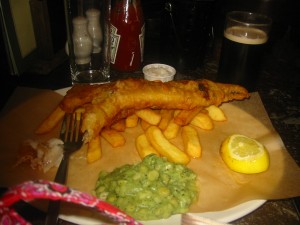 It was actually the best fish and chips I’ve had in the city.
It was actually the best fish and chips I’ve had in the city.
Just when I thought my troubles were over, I was suddenly facing a new dilemma. DO I TIP? Is it offensive if I do? Is it rude if I don’t, especially as they’d taken such good care of me? I paid my bill with exact change and, after that was cleared away, made much of checking my phone while I reached down into my purse to get another pound coin and a piece of paper. I wrote a little note, saying simply: “Thank you!” and placed it and the coin on the table as I got my bag and prepared to go, taking the last sip of Guinness. Unfortunately, my waiter then came over to take my glass and, seeing the note, read it quickly and picked up the tip. My cheeks turned red and I feared I was about to face the biggest monster of English behaviour- the cold shoulder combined with the dislike of money! I needn’t have worried, as it turns out: my waiter looked me straight in the eye and said gratefully “Oh, thank you! That was very nice of you” in an accent that was clearly not British and hinted that he too was a stranger in this strange country where money is considered dirty. Relieved to have not caused offence, I gushed “Oh, well, phew! I’m still trying to learn how all this *gesturing around, indicating the pub* works”
He smiled at me and said “Me too.”
So now the pub is not a location I visit petrified with terror, but I still prefer the peace and quiet of casual drinks with friends or at a restaurant then entering the realm of the pub, laden with social booby-traps as it is.
Tags: 2010 Elizabeth · Pubs
September 19th, 2010 · No Comments
After reading the title of this post, anyone not familiar with our class wiki may be expecting an intellectual argument for or against the book 1984, or any of Orwell’s other great works. Instead, I’m going to talk about alcohol, specifically the drinking of it. Actually, I lied, kind of. I’m in fact preparing to discuss an essay that Orwell wrote called The Moon Under Water (for those who haven’t read it, here’s the link: http://www.netcharles.com/orwell/essays/moon-under-water.htm), which discusses the characteristics of the perfect pub in Orwell’s eyes. So, this post won’t be so much about drinking as it will be about the venues for drinking (which should make a lot of people happy, especially my parents).
In case you’re too lazy to read Orwell’s very brief, but very interesting essay, I’ll summarize it for you. Basically, Orwell describes a pub, which we later find out is fictional, that has ten qualities that make it perfect. These are:
1. The architecture is Victorian.
2. Darts are only played in the public part of the bar, which allows people to drink without having to duck.
3. The pub is quiet enough to talk, with no radio or piano.
4. Barmaids that know their customers by name and take an interest in them.
5. The bar sells tobacco and cigarettes, in addition to booze.
6. There is a snack counter that serves “liver-sausage sandwiches, mussels, cheese, pickles and […] large biscuits with caraway seeds.”
7. Six days a week, they serve lunch — for example, a cut off the joint, two vegetables and boiled jam roll.
8. “[…] a creamy sort of draught stout […].”
9. Extreme care is taken with their drinking vessels and they never, for example, make the mistake of serving a pint of beer in a handleless glass.
10. A large garden.
Looking at this essay 64 years after it was written, some of these things look like no-brainers that are characteristic of every modern pub (like a dart board being out of the way, or the pub having a nice stout) and some seem just silly, like beer not being served in a handleless glass or a pub having a garden. Despite these, if I were to characterize my ideal pub (which I’m going to) I would have to say that it would have all of these characteristics, except for numbers 5 and 9, and maybe number 1. Being completely unable to imagine a Victorian pub (mostly because when I think of “Victorian” buildings, I can only think of my aunt and uncle’s stuffy, uncomfortable Victorian-decorated houses), I don’t really know if that kind of decor is important to me or not. However, I’m going to assume that a Victorian pub looks like a stereotypical English pub, which, if true, would mean that Victorian architecture is definitely an important trait of a great pub. A pub just wouldn’t be a pub without being really dark at all times of the day, with dark wooden walls, a couple of old looking paintings, etc.
Unfortunately, I haven’t really found a pub that matches all of the criteria. Most pubs are so loud at any time of the day that it’s impossible to hold a proper conversation without yelling, and I’ve never seen a pub with a garden. However, I have found one pub that gets pretty darn close to my ideal. Sadly, I only discovered it today, so I won’t have much time to go back. It probably has the best name for a pub, at least in the opinion of the part of me that loves Shakespeare, because it is called The Globe, despite being nowhere near the famous theatre, being instead located very near the Covent Garden Market. Forgetting the garden requirement because no pub nowadays has a garden and number 4 because I’ve only been there once (though the staff seem nice), The Globe meets all of my criteria, if I understand what a Victorian pub looks like. I don’t even think they own a dartboard, which means they pass number 2 by default, and the pub was almost silent when we were there, which is a rarity that is much appreciated when it is seen. They seem to have a very nice menu, though the four of us (the members of the Origins of Rock and Roll in London tour group, a.k.a The Fab Four) only got an order of chips, food-wise. They have Guinness (a stout), which is really the only beer I ever need, and they seem to take care of their drinking glasses rather well. Therefore, I guess if I needed to pick a “favourite” pub, it would be The Globe.
Now to take a different tact on the same basic theme, I guess I’ll briefly discuss the hidden rules of pubs, which are only truly hidden for any of us who haven’t read Kate Fox (which I hope is not many, if there are any at all, because it is a wonderful, though sometimes inaccurate book). Today was actually my first experience buying drinks in rounds (technically round), so I can’t really talk much about this ritual from experience, but it seems to happen, as Fox said it does. The basic principle for those who don’t know is that when a group is out drinking, people will take turns going up to the bar to buy drinks for the group instead of ordering individually. There are, of course, many variations, but that’s the basic idea. Another important rule is that of buying the bartender a drink rather than tipping him or her. Because I never drink a lot when I go out, I’ve never really done this, because it makes much more sense if he or she has given you a few drinks, rather than just one. In fact, the only time that I was part of a group that tried to buy a bartender a drink, she refused it (it was lunchtime and she wasn’t English, which probably makes a difference). Therefore, I really can’t speak to the validity of this particular rule. Those are really the only two rules that I remember observing (or not observing) in my limited pub experiences. If anyone with more experience can think of anymore, please let me know!
Tags: 2010 MatthewM · Pubs
September 19th, 2010 · 1 Comment
Note: much of the following appears, verbatim, in this Thursday’s Dickinsonian. The formatless-format is explained there, but the manner in which it is done there is incongruous with this blog.
As our syllabus eloquently says, “London is too vast—as both a place and an idea—to grasp it all.” Conveniently, it’s more my style anyway to tell a few short anecdotes and leave it to the reader to weave them together rather than give one lengthy narrative.
That said, here are a few random moments that I’ll remember well after we’re back in the states.
On a subway ride back from Westminster one Sunday, a large man wearing a suit and tie (although his collar was covered in food) came up ranting and raving to our group of four Americans. “That guy sitting next to me over there was [fondling] his girlfriend! I don’t care if you do it a hundred times at home, but not on the f**king Tube! I AM TRYING TO CONCENTRATE!” It should be noted that this man, allegedly deep in concentration, was not reading, working, or listening to music. He was simply “trying to concentrate.” At first, I found this hilarious. But the more I thought about it, the more I thought it articulated the philosophy of the stoic and silent Brits we see every day on the Tube. Many do not read, many do not listen to music. But all do not speak to or make eye contact with each other. They’re just trying to concentrate.
_______
British women, or at least women in London, are really tall.
_______
We’ve taken all kinds of tours. We’ve toured places: Westminster Abbey, St. Paul Cathedral, the University of Oxford, Greenwich, Bloomsbury, the East End, and Stratford. We’ve done tours with themes: Marx’s London, Roman London, Restoration London. As Pat put it, though, “I’d like to take a trash cans, bathrooms, and water fountains tour, as there are none of those things in this city.” You can walk for miles in Westminster and not see a single trash can; they have all been removed from the area around Parliament and the prime minister’s residence because of susceptibility to terrorist attacks.
_______
Things in London close very early by American standards. Most restaurants outside of Burger King and McDonald’s are closed by 9:00 (or, as it’s known here, 21:00) and earlier on Sundays. So it was a major pleasant surprise when a few of us found a Subway that was open nightly until 5:00 AM. But it was extremely bewildering? Why this Subway, when four more from the same chain within two miles close around the usual London time?
This mystery was solved when it was realized that there was a strip club across the street that was open until 4:00 AM nightly.
Tags: 2010 Dennis · Uncategorized
September 19th, 2010 · No Comments
The thing about a city is you always end up missing the country and the thing about the country is you always end up missing the city. This paradox is one of the reasons I’ve been happily tucked away in a suburb for most of my life (I was born in Culver City, but we left Los Angeles before I had turned four)- give me access to the things in the city that I want but with the quiet and amenities only the country can provide.
London, however, has found a better solution to the need for getting away from the city: the plethora of parks and green space that dot the metropolis like a leaky pen on super-absorbent Bounty roll. I don’t understand the psychology of it, but there’s something about having a park, “a bit of earth” as the musical The Secret Garden says, that calms the human mind. Having somewhere to walk your dog, go for a run, bicycle around, take the kids roller-skating, have a picnic, read a book, whatever you wish, somehow relieves the pressures of city life. How the park-goers cope with inclement weather, I’ve yet to observe, but I know just finding “somewhere that’s green” (again, a musical reference – Little Shop of Horrors- I’m just on a roll tonight!) is seemingly vital to the psyche of any Londoner.
I began to feel this pull toward the park myself when I was heading over to visit the Queen’s Gallery at Buckingham Palace. I exited the Tube at the aptly-named Green Park station and discovered myself to be in the midst of an enormous, sprawling park, heavily populated with people (mostly families) spending the day outside and enjoying the weather. Touched by the idyllic scene, I snapped a photo and then starting heading over to the Palace. After turning one or two corners, it was as if I had travelled to a different world instead of only walking further away from the park. The peace and tranquility of the community park was replaced with loud, overexcited tourists, all eagerly clamouring for a photo of the Palace and/or the guards. People continually bumped into me as I tried to get to the Gallery and I had to look around me at all angles to make sure I didn’t step into anyone’s photos.
Viewing the gorgeous art at the Gallery refreshed me slightly but, after fighting my way back through the crowds around the Palace gate’s, I stopped in Green Park to take a breather before heading into the congestion and confinement of the Tube station.
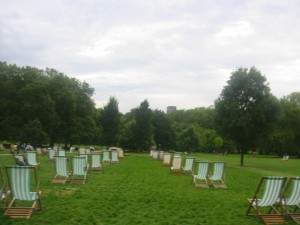 Where to find peace? Green Park!
Where to find peace? Green Park!
A young woman might have once needed a room with a view in Italy, but I began to understand just how much the English need their room and green views [see what I did there?]
Tags: 2010 Elizabeth
September 19th, 2010 · 3 Comments
I have been to many pubs in London, though probably not as much as some of my group members. The fact is, I don’t really like them. Before I came to England, I had the idea that pubs would be low-key and intimate places. I thought they would be places where I could relax. It turns out to be the opposite. I can’t relax at these places. I get extremely anxious. Pubs are where I actually have to act British, and I am not too sure yet what that means. I have read Fox and she has helped, but the times I actually experienced the pub scene for myself I’ve been confused. In the moment, I have a hard time thinking about what Fox has told me to do, and I just do what David always does… and it’s not always pretty.
One experience that I had was when Sean and I went to the Rising Sun. We made our way to the bar and, after probably five minutes of waiting, the bartender came and asked what we wanted. I ordered a pint of London Pride, and the guy asked if that was all and I said yes. But, then Sean said he wanted one too so I said, “Wait actually my friend wants one too.” Strike one. When you order, know what you want and order it all together. So the bartender gave me an attitude and then started to pour Sean’s drink. When he was finished, he gave us the price of the two drinks. We went fumbling through our pockets, full of random coins that we hadn’t yet learned by touch, so we could pay separately for the drinks we ordered. Strike two. Be ready with the money and pay together so the transaction can be fast, especially on a busy night like this one was. No need for a third strike, the bartender had no sympathy for the two confused Americans. When we eventually paid, we got our drinks and went to sit. We found a group of girls from the program, and I had to take Melissa with me when I wanted another drink because of how embarrassed I was. But experiences like this are not the only reason I don’t like pubs.
Pub food is garbage and the atmosphere is uncomfortable. I don’t care if its steak and ale pie, potato jackets, or a burger. The only thing that’s actually good is the fish and chips, but really how could anyone mess that up. This food is really missing all and any flavor that it could have. I really prefer to go to restaurants to eat and drink. The food is usually better and just as cheap. The drinks too are usually just as expensive. I like the slower pace of restaurants because I can eat and drink without people yelling and their elbows in my plate.
On a recent night, however, I was surprised to find a pub that I actually liked. It was small and quiet. When I looked in the window I hesitated before going in because it looked so low-key that I was worried it was a kind of a “regulars” spot. But when I walked in (with Sean) I found that it was exactly the kind of place I had been looking for! Sean and I were probably the youngest people there. There was no music. The place wasn’t full but the people there were actively engaged with who ever was across from them at their table. I felt relaxed, I felt comfortable, and I drank a lot. I think the pub’s name was the King’s Crown. It’s a little bit up Gower Street, on a street to the left. I recommend that before everyone leaves, they give this place a shot because I’m sure it’s different than any place you have been to so far. I will totally be going back before I leave.
I hope to find pubs, like the one I just spoke about, in Norwich. I know pub food is notoriously bad everywhere, but I just want a place I can relax and unwind. That’s it.
Tags: 2010 David · Uncategorized
September 19th, 2010 · No Comments
As a firm agnostic, I know I visited all the different religious sites (the churches, the mandir, the mosque, and the synagogue) with different feelings and expectations than many of my colleagues. While I found our visits to the non Judeo-Christian places particularly informative, I felt the same apathy during those visits that I felt at the other places of worship. We’ve been told over and over again that Britain is a secular country and, for me, that works out just fine. Understanding this, it should be no surprise that my two favorite buildings to visit were Westminster Abbey and St. Paul’s Cathedral, locations that I have heard many bemoan as having become too much like tourist attractions rather than churches.
I could have happily wandered about Westminster Abbey a whole day (so long as I could avoid the tourists with the bloody audio guides who were walking about like zombies!), visiting the different tombs and reading all the different plaques and memorials. The sheer amount of history in that building is staggering. Despite my lack of religion, walking around the tomb of Queen Elizabeth I was a profoundly moving, almost spiritual, experience. It was if the gap between the past and the present could be breached by the closeness of that past’s remnants.
 Me in front of Westminster Abbey
Me in front of Westminster Abbey
At St. Paul’s, I didn’t feel the tug of history quite as strongly but I was perhaps even more impressed with the artistic aspects of the building, particularly the interiors. Knowing my own limits (stupid asthma), I decided not to ascend the stairs to see the top and, instead, spent a long time looking at the different gorgeous paintings and mosaics, particularly those adorning the ceiling.
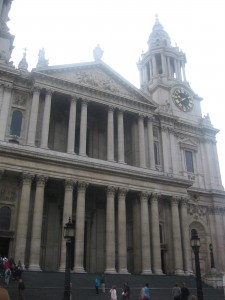 The entrance to St Paul’s.
The entrance to St Paul’s.
Something I noticed at both St. Paul’s and Westminster Abbey was the moment of silence/prayer that occurred during our visits. I applaud this attempt to remind visitors where they were but think it fell flat both times, as many tourists (particularly the children) ignored the announcement and continued on their merry way, many obviously still zoned out and intent on their audio guides. I think that the historic houses of worship in England need to make up their minds one way or another: do they want to remain religious buildings or give over entirely to tourism? This indecision has the buildings in an odd sort of limbo- not entirely sacred, but not secular either.
Tags: 2010 Elizabeth · Churches and Cathedrals
September 19th, 2010 · No Comments
I’m a huge theatre fan (always have been, always will be), so pretty much every moment of spare time I’ve had here that hasn’t been taken up by projects or illness has been spent at the theatre. Many people have already written about individual shows, so I’m going to try and give a comprehensive look at what I’ve seen here in London and where:
–The Merry Wives of Windsor, The Globe Theatre (Southwark/Bankside)
-The 39 Steps, The Criterion Theatre (Piccadilly Circus)
–Bedlam, The Globe Theatre (Southwark/Bankside)
–Aspects of Love, The Menier Chocolate Factory (Southwark)
– Les Miserables (the 25th Anniversary production), The Barbican Centre (Southwark)- TWICE
–Henry IV: Parts One and Two, The Globe Theatre (Southwark/Bankside)
–Passion, The Donmar Warehouse (Covent Garden)
–Wicked, The Apollo Victoria (Westminster)
I’m only going to mention my experiences at the Globe briefly, as I’ve been going to bat constantly in defense of Bedlam and it’s sort of exhausting! I found Merry Wives to be entertaining – it’s not one of my favourite Shakespeare plays, but the cast was fantastic. I saw Bedlam on opening night – its world premiere performance – and I was blown away by it. I wanted to go back and see it again but that didn’t end up working out, though I did pick up a souvenir program and a script on my Henry IV Marathon Day.
Ah, and speaking of Henry! . . . As part of the educational Shakespeare company I interned with for two years, I assistant directed Part One of Henry IV twice, so I was very familiar with the show. I decided to go on a day where I could see both Part One and Part Two which equalled about 8 hours spent in or near the Globe- HEAVEN! I thought the cast of both Parts gave extremely strong performances, particularly Roger Allam as Falstaff and Jamie Parker as Prince Hal. It was also entertaining to see cast members from Bedlam playing different roles, sometimes bit parts really, which made me pay much more attention to them. It was so interesting to see Sam Crane (the foppish Laurence in Bedlam) as Hotspur in Henry or Phil Cheadle, who stole my heart as Doctor Maynard in Bedlam, playing a trio of small roles (Douglas/Davy/Lord Bardolph), or Jason Baughan, the mad doctor in Bedlam, as Westmoreland/Peto, or even seeing Barbara Marten, the neglected wife in Bedlam, as the hillarious Mistress Quickly in Henry. My only complaint about the Henry plays is that I would have liked to see them before Merry Wives, as Merry Wives is the sequel to both Henry IVs and Henry V. Still, knowing the characters and what becomes of Falstaff in Merry Wives made the Henrys all the more enjoyable!
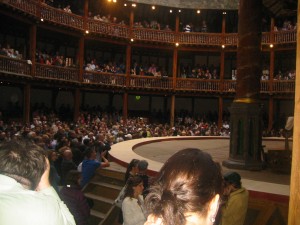 My view of Bedlam (taken during the interval, of course!)
My view of Bedlam (taken during the interval, of course!)
And me at the site of the original Globe.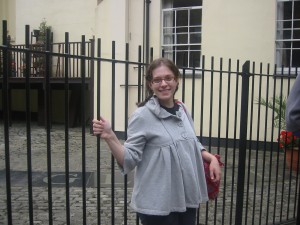
I was pleasantly surprised by The 39 Steps. I didn’t know anything about the play or the cast but, being a film fan, knew that the title at least came from a Hitchcock-type, film noir-ey movie. Imagine my surprise when I discovered it was more spoof than thriller! The Criterion itself was BEAUTIFUL, a gorgeous venue and perfect for such an affectionately-nostalgic play. The UK tour will be hitting Norwich in April, so I’m going to try and go to see if I like it as much with a different cast.
Now. Les Miserables. Bear in mind that I’ve seen Les Miz more times than I would like to admit, have more cast recordings than I’d like to count and in more languages than I should probably tell. This musical was a huge part of my life for about 3 years in high school and had a huge shaping effect on my musical tastes. I didn’t want to see the production at the Queen’s Theatre because it was a bit of “been there, done that”- let me explain to the uninitiated: pretty much all of the musicals Cameron Mackintosh produces (Phantom of the Opera, Cats, Les Miz, Miss Saigon, etc) are brilliant shows but get boxed up and set to be mass produced globally. That basically means, the blocking, lighting, staging, set, costumes, all the onstage “business” will be the same from production to production. That cross Valjean makes downstage left in the middle of Act 2 will be made by every Valjean from Alaska to Hong Kong. That was why, when I heard there was a special, newly restaged version being presented at the Barbican (the original home of Les Miz’s first production) in honour of its 25th Anniversary, I jumped at the chance to go.
To try and express how incredible this production was is beyond me at this point, particularly as I’m tired, sick and sniffly. Suffice it to say, it was MAGICAL. The creative team took a show that I know inside and out, blast its stitches apart and made it something fresh and new, while keeping the same heart, the very core of the show which I fell in love with in the first place. They did away with the annoying rotating stage and used a much more intimate, less intimidating set. New costumes. New orchestrations. New musical cuts. New lighting. I had goosebumps from the sheer awesomeness of it.
Which is why, after getting out of the show Wednesday night (the 15th), I immediately called my partner in crime and fellow Les Miz fanatic, Stephenie, and told her she NEEDED to get tickets. Before I quite knew where I was, we had tickets for the very next night’s performance and were seeing the show together. Seeing the show by myself had been amazing enough but having someone with me who could understand my strange musical-fan language and decipher from just an elbow in the ribs my excitement at the inclusion of a moment from the original novel into the stage production was beyond awesome!
 [At the Barbican. Photo grudgingly taken by Stephenie :D]
[At the Barbican. Photo grudgingly taken by Stephenie :D]
Oh, and we stood at the stage door to get our programs signed. Everyone but the two of us left after Gareth Gates (who played Marius and was, apparently, on the British version of American Idol, or something) had gone, so we were the only ones waiting for Valjean and the other leads- which is VERY STRANGE in the world of Stage Door. We had to call after John Owen Jones (who played Valjean, and is, in my mind, a demi-god) to get him to stop. So, we awkwardly stood at the stage door until 11:30pm (which, no doubt, led to my getting sick) until we decided to head back to the Arran House. We got on the tube at Barbican and decide to transfer to Moorgate so we can take the Northern line to Goodge. Still with me? So we’re walking through the station to get to the right platform and who should pass us? John Owen Jones (Valjean). Yep. And we were the only two at stage door, plus I was wearing my Les Miz shirt and Steph had her program out so we looked like complete stalkers. Did I mention he had left 20 minutes before we did? So how did he end up getting off at Moorgate at the same time? It astounds me . . . . And guess where he was headed? Yes, the Northern Line! He got into the same CAR as we did and Steph and I tried to remain calm and casually take some stealthy stalker photos of him (fail) but he got off at King’s Cross before we could succeed.
Going back a bit further, there is one theatrical experience which I must list as my favourite: Aspects of Love, at the Menier Chocolate Factory. This is one of Andrew Lloyd Webber’s least-well known shows (it is my personal favourite, even above Phantom of the Opera) and it was a miserable failure on Broadway and only played 3 years in London. I knew about the upcoming production before I had even left the States and I was thrilled, as this is the first major production in London since the original. This show is LITERALLY never put on, especially not in the United States (I saw a truly abysmal concert version in Los Angeles my senior year of high school which I’ve tried to erase from my memory). My pet theory on this is that it’s just not a flashy, pretty spectacle-type musical: it’s a deeply moving exploration about the agony of love as told through an incredibly complex story and fantastically beautiful music. To find out more about the show, take a look at: http://en.wikipedia.org/wiki/Aspects_of_love. The Menier is my favourite theatre I’ve visited so far- it is a huge success story, as it operates entirely without any government support and, thereby, is able to produce some truly incredible theatre. It has all the closeness and intimacy of a local community theatre with the talent of a full-scale West End production. Do check out their website: http://www.menierchocolatefactory.com/pages/about_us
The show itself was fantastic- I couldn’t have asked for a better production. To make things even better, I proved that Kate Fox is wrong about the English’s coldness and made friends with the girl working in the box office (whose name- Amanda- it only took me till the interval to find out!) as we mutually geeked out about how much we love the musical. I arrived home on a cloud of musical-induced bliss!
And, most recently, last night I saw Stephen Sondheim’s musical Passion at the Donmar Warehouse (http://www.donmarwarehouse.com/pl111.html) with Stephenie. As with Aspects of Love, this is a show whose music I know extremely well but which is not successful or oft performed because of its intensely emotional, cerebral nature. The Donmar is an incredible theatre – like the Menier, known for its intimate space- and it was the perfect setting for such an emotional complex and poignant piece of music as Passion.
 [Passion logo from: http://3.bp.blogspot.com/_1DZU-LyGw2Q/TFJkwODs5JI/AAAAAAAABLg/F-ss3TaKSSU/s1600/passion.jpg]
[Passion logo from: http://3.bp.blogspot.com/_1DZU-LyGw2Q/TFJkwODs5JI/AAAAAAAABLg/F-ss3TaKSSU/s1600/passion.jpg]
As for the last one on my list, Wicked, it’s a show I’ve seen often in Los Angeles. Stephenie and I (along with some others, I believe) are going Tuesday night before we head out of London. It’s by far the most commercial/touristy of the musicals I will have seen here, but I am looking forward to it nonetheless and am interested in seeing some changes that I believe were made to the show when it came here to London.
If I take away nothing else from this time in London, I’ll have gotten to see some damn good theatre!
Who could ask for anything more?
Tags: 2010 Elizabeth · Theatre
















